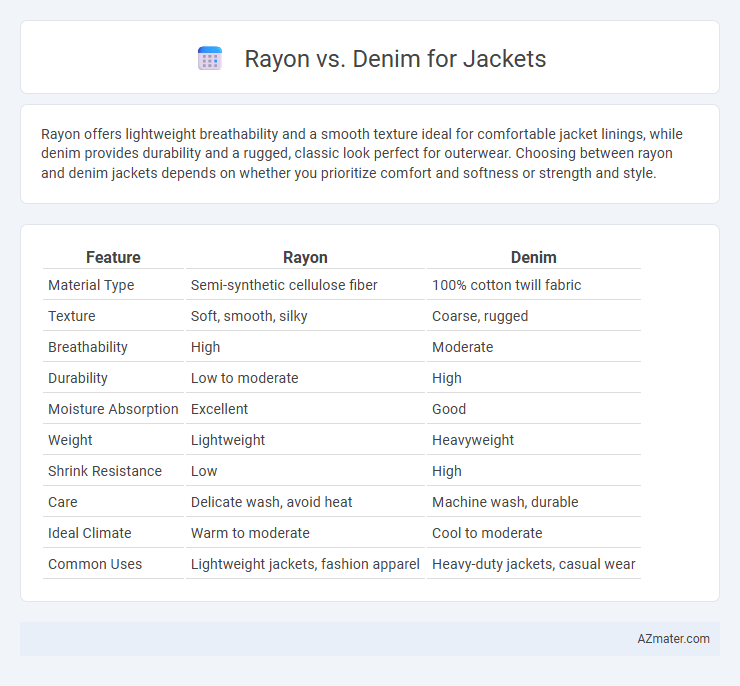Rayon offers lightweight breathability and a smooth texture ideal for comfortable jacket linings, while denim provides durability and a rugged, classic look perfect for outerwear. Choosing between rayon and denim jackets depends on whether you prioritize comfort and softness or strength and style.
Table of Comparison
| Feature | Rayon | Denim |
|---|---|---|
| Material Type | Semi-synthetic cellulose fiber | 100% cotton twill fabric |
| Texture | Soft, smooth, silky | Coarse, rugged |
| Breathability | High | Moderate |
| Durability | Low to moderate | High |
| Moisture Absorption | Excellent | Good |
| Weight | Lightweight | Heavyweight |
| Shrink Resistance | Low | High |
| Care | Delicate wash, avoid heat | Machine wash, durable |
| Ideal Climate | Warm to moderate | Cool to moderate |
| Common Uses | Lightweight jackets, fashion apparel | Heavy-duty jackets, casual wear |
Introduction to Rayon and Denim
Rayon is a semi-synthetic fiber derived from cellulose, known for its smooth texture and breathability, making it ideal for lightweight, comfortable jackets. Denim, a durable cotton twill fabric characterized by its diagonal ribbing, is favored for rugged, long-lasting jackets with a distinctive casual style. Choosing between rayon and denim depends on the desired jacket attributes such as softness and airflow versus strength and classic appeal.
Key Differences Between Rayon and Denim
Rayon is a semi-synthetic fiber known for its smooth texture, breathability, and lightweight feel, making it ideal for comfortable, drapey jackets suitable for warmer climates. Denim, a durable cotton twill fabric, offers robust strength, texture, and a structured fit, often preferred for casual, rugged jackets. Key differences include rayon's moisture absorbency and softness compared to denim's toughness and resistance to wear and tear.
Fabric Composition and Manufacturing
Rayon jackets are crafted from semi-synthetic cellulose fibers derived from wood pulp, offering smooth texture and enhanced breathability through a wet spinning manufacturing process. Denim jackets utilize 100% cotton or cotton blends woven into a durable twill fabric, characterized by diagonal ribbing created during the weaving stage, ensuring ruggedness and longevity. The manufacturing methods of rayon emphasize fiber regeneration and chemical treatment, whereas denim production prioritizes yarn dyeing and heavy-duty weaving techniques.
Comfort and Wearability
Rayon offers exceptional softness and breathability, making it a comfortable choice for jackets in warmer climates due to its moisture-wicking properties. Denim, known for its durability and robust texture, provides a structured fit but can feel stiff initially and may require breaking in for enhanced comfort. Balancing wearability, rayon jackets excel in lightweight comfort and flexibility, while denim jackets are favored for their long-lasting resilience and classic style.
Durability and Longevity
Denim jackets offer superior durability and longevity due to their tightly woven cotton fibers and rugged twill weave, making them resistant to wear, tear, and frequent washing. Rayon jackets, while softer and more breathable, tend to have lower durability as the semi-synthetic fibers break down faster under stress and repeated laundering. For long-lasting outerwear, denim remains the preferred choice because it withstands harsh conditions and maintains structural integrity over time.
Style and Aesthetic Appeal
Rayon jackets are prized for their smooth texture and vibrant color retention, offering a sleek, polished look ideal for sophisticated and lightweight styles. Denim jackets provide a rugged, timeless appeal with durable fabric and distinctive faded or distressed finishes, perfect for casual and edgy aesthetics. Choosing between rayon and denim depends on desired style versatility, with rayon leaning toward formal elegance and denim embodying classic, versatile streetwear.
Seasonal Suitability: Weather and Climate
Rayon jackets excel in warm, humid climates thanks to their breathable fibers and moisture-wicking properties, making them ideal for spring and summer wear. Denim jackets, known for durability and thicker fabric, provide better insulation and wind resistance, suited for cooler seasons like fall and mild winter. Choosing between rayon and denim depends on tracking temperature fluctuations and humidity levels to ensure comfort and functionality.
Maintenance and Care Tips
Rayon jackets require gentle hand washing or dry cleaning to prevent fabric weakening and maintain softness, while denim jackets are more durable, allowing for machine washing but should be turned inside out to reduce fading. Avoid high heat drying for both fabrics to prevent shrinkage or damage, with rayon benefiting from air drying and denim from low heat settings. Storing rayon jackets in breathable garment bags preserves fiber integrity, whereas denim jackets benefit from occasional brushing to remove dust and maintain texture.
Sustainability and Environmental Impact
Rayon jackets, derived from cellulose fibers, offer a biodegradable alternative with lower water consumption compared to denim, making them more sustainable in production. Denim jackets, typically made from cotton, require significant water usage and pesticide-intensive farming, leading to higher environmental impact. Choosing rayon over denim can reduce carbon footprint and support eco-friendly fashion practices through renewable sourcing and reduced chemical treatments.
Choosing the Right Fabric for Your Jacket
Rayon offers a lightweight, breathable option for jackets, making it ideal for warmer climates and casual wear, while denim provides durable, heavier protection suited for cooler weather and rugged use. Choosing between rayon and denim depends on the jacket's intended function, considering factors like breathability, texture, and durability preferences. Denim jackets excel in longevity and structure, whereas rayon jackets prioritize comfort and drapability for a stylish, relaxed fit.

Infographic: Rayon vs Denim for Jacket
 azmater.com
azmater.com